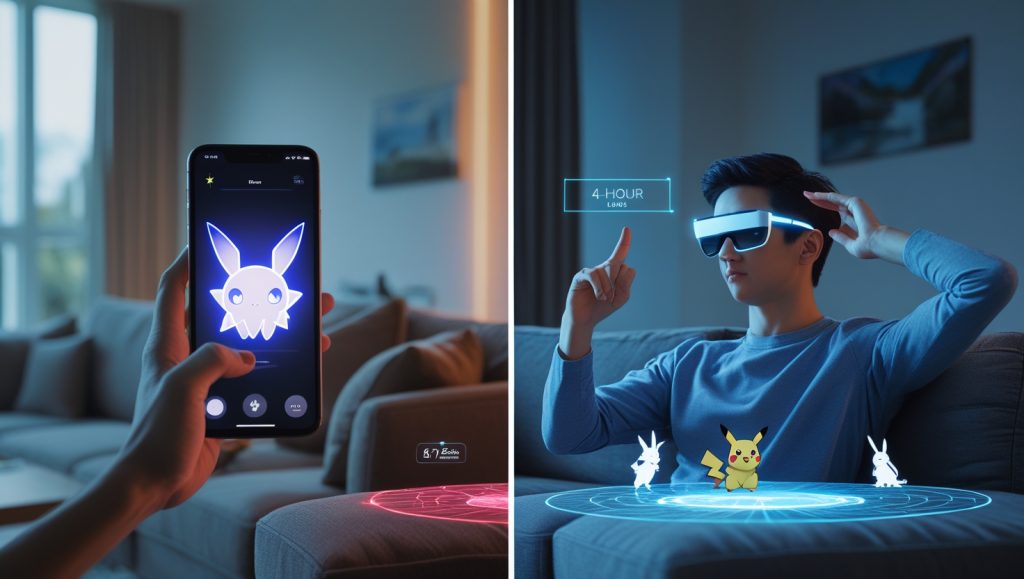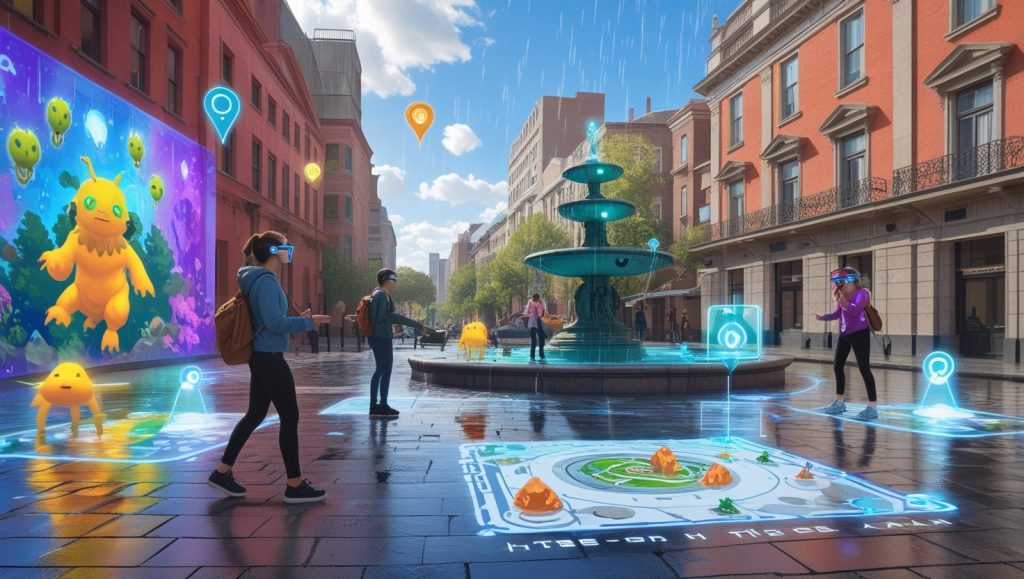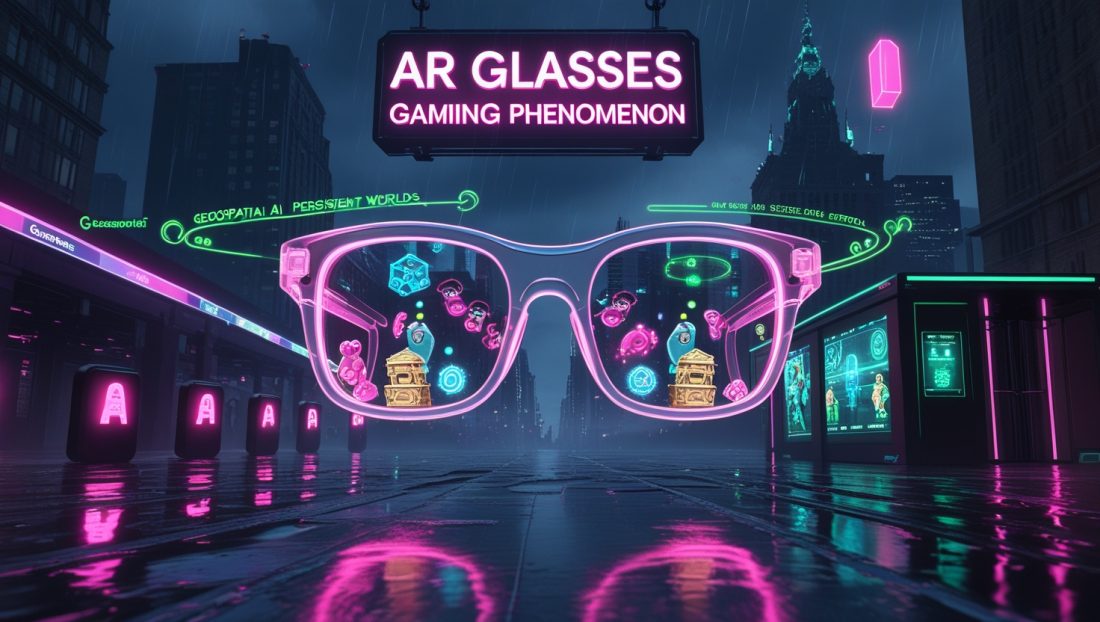What If Your World Became a Game?
What if your morning walk turned into a quest for digital treasures, historical insights, or collaborative adventures—all without touching a phone? This is the future Apple and Niantic are crafting. Pokémon GO redefined gaming in 2016 by blending augmented reality (AR) with real-world exploration, but its smartphone roots feel clunky today. Apple’s AR glasses, paired with Niantic’s geospatial AI, could unleash the AR glasses gaming phenomenon, transforming how we play, connect, and explore. Here’s how this duo could reshape daily life, grounded in current tech advancements.
The Pokémon GO Legacy: Setting the Stage for the AR Glasses Gaming Phenomenon

Pokémon GO wasn’t just a game—it was a global movement. By overlaying digital creatures onto real-world maps, Niantic got millions moving, collaborating in parks, and chasing nostalgia. Its success came from accessibility (any smartphone worked), social engagement (players met in real spaces), and leveraging a beloved franchise. Yet, holding a phone to “catch” Pikachu feels dated. Apple’s AR glasses aim to make this seamless, projecting AR directly into your view.
Tim Cook has said AR lets users “be present in the world but improve what’s happening.” This vision drives Apple’s glasses, designed to erase the barrier between you and the game. For more on immersive gaming, our analysis of PlayStation VR3’s haptic feedback shows how hardware is evolving.
Niantic’s AI Maps: Powering the AR Glasses Gaming Phenomenon
How AI Maps Create Immersive Worlds
While Apple perfects hardware, Niantic builds the digital foundation for AR. Their Large Geospatial Model (LGM), trained on 50 million neural networks and 10 million 3D scans, lets machines understand physical spaces—your backyard’s layout, a desk’s height, or a street’s history. This isn’t just about placing Pokémon; it’s about persistent AR worlds where digital objects stay fixed, visible to all players.
John Hanke, Niantic’s CEO, sees AI moving “beyond the screen and into the real world.” Combined with Apple’s LiDAR, which enhances depth perception in iPhones, this tech could make the AR glasses gaming phenomenon feel alive, with Pokémon hiding behind real trees or quests tied to local landmarks. Curious about AI’s role in gaming? Our piece on Roblox’s AI tools for 2025 explores similar innovations.
Why Smartphones Can’t Match AR Glasses

The Limits of Phone-Based AR
Pokémon GO’s “AR+” mode lets you snap Pokémon in your environment, but it’s tethered to a phone. Apple’s AR glasses offer hands-free immersion with features like lightweight frames, all-day battery life (unlike Meta’s Ray-Bans, which last four hours), and gesture controls like pinching to interact. Apple’s LiDAR, already in iPhones, delivers precise depth mapping, enabling context-aware gameplay—think Pokémon perched on your couch.
This setup also prioritizes privacy with on-device processing, reducing cloud reliance. For tips on optimizing mobile gaming, our guide to fixing COD Mobile login errors offers practical solutions.
Challenges Holding Back the AR Glasses Gaming Phenomenon
Technical Barriers to Overcome
Battery life remains a hurdle—current AR prototypes drain fast, but Apple’s M3 chip could boost efficiency. Micro-OLED screens must also balance brightness and power use for crisp visuals.
Social and Ethical Concerns
Google Glass flopped due to its “creepy” camera vibe. Apple must design subtle glasses to avoid this stigma. Niantic’s geospatial data, built on user scans, raises privacy worries despite claims of anonymization. Critics fear aggregated data could reveal sensitive patterns. For more on gaming privacy, our article on Blood Strike’s friend limit issue dives into user concerns.
Apple and Niantic: A Perfect Pair for the AR Glasses Gaming Phenomenon
A Symbiotic Partnership
Niantic’s shift to Niantic Spatial aims to map the world for AI, using 10 million crowdsourced 3D scans from games like Pokémon GO. This data trains AI to predict unseen spaces, like a building’s full structure from partial scans. Apple’s Vision Pro, launched in 2024, tests spatial computing, while AR glasses will make it consumer-friendly by cutting costs and enhancing ARKit 6 for developers.
In 2024, Niantic and Punchdrunk collaborated to blend AR with theater, turning users into heroes of location-based stories. This could make cities playgrounds for the AR glasses gaming phenomenon, with quests tied to real-world landmarks.
The Future: AR as a Platform, Not an App

Endless Possibilities for AR Gaming
The next Pokémon GO won’t be one game but a platform for countless experiences. Picture dynamic quests that shift with weather, multiplayer mysteries tied to landmarks, or AI-driven pop-up events like virtual concerts. Niantic’s Punchdrunk partnership hints at this, merging theater-grade narratives with AR to make cities interactive stages.
A real-world example: In Austin, a teacher testing Apple’s AR prototype navigated a field trip with glasses that highlighted historical murals, suggested Pokémon, and overlaid directions—all hands-free. This is the AR glasses gaming phenomenon in action.
FAQ: Common Questions About the AR Glasses Gaming Phenomenon
When will Apple’s AR glasses launch?
Analysts point to 2026–2027, depending on battery and display advancements.
Will they be affordable?
Prices may start at $1,500–$2,000, but sub-$1,000 is key for mass adoption.
How will privacy be handled?
Apple’s on-device processing minimizes cloud risks, but Niantic’s data practices need transparency.
Can phones support advanced AR?
Phones with LiDAR offer basic AR, but glasses enable deeper, hands-free immersion.
Will Pokémon GO adapt for AR glasses?
Niantic teases new mechanics, likely with cross-device support.
The Dawn of a New AR Era
Apple’s AR glasses and Niantic’s AI maps are two sides of a coin, poised to spark the AR glasses gaming phenomenon. Success hinges on affordable hardware, intuitive design, and transparent data policies. By blending nostalgia with cutting-edge tech, they could make AR as vital as smartphones. Stay updated with creedtec.online for the latest on AR and gaming tech. Share your thoughts—will this duo redefine play?



